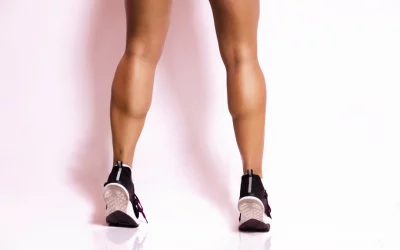When your shoulders feel tight or overworked, deltoid stretches can make a big difference. Proper stretching improves flexibility, reduces tension, and supports recovery after exercise. Whether you’re targeting the anterior, posterior, or the entire shoulder, knowing the right techniques is key.
This article highlights the benefits of deltoid stretching, including improved posture, better range of motion, and reduced muscle tightness. It provides step-by-step instructions for effective deltoid stretches and practical tips for incorporating them into your daily routine.
Whether for recovery or maintaining shoulder health, this guide ensures your deltoids get the care they need.
Benefits of Deltoid Stretching
Stretching your deltoid muscles enhances shoulder health and overall well-being by improving mobility and addressing tightness caused by repetitive activities or poor posture. The deltoids play a crucial role in shoulder movement and stability, making regular stretching essential for maintaining flexibility and proper posture.
Improved shoulder flexibility from deltoid stretching makes everyday tasks and physical activities easier and more efficient. Regular stretching also reduces the risk of injuries by keeping muscles pliable and supporting joint mobility, which helps prevent strains and tears during sudden or repetitive movements.
Deltoid stretches alleviate muscle tension, improve posture, and support athletic performance by enhancing range of motion and muscle functionality. Additionally, stretching promotes relaxation, helping release built-up tension and fostering both physical and mental balance.
Effective Deltoid Stretches
 1. Cross-Body Shoulder Stretch
1. Cross-Body Shoulder Stretch
The Cross-Body Shoulder Stretch is particularly useful for improving shoulder flexibility and relieving tension in the back of the shoulder, which can often become tight because of prolonged activities like typing, carrying heavy objects, or repetitive overhead movements.
To perform the Cross-Body Shoulder Stretch:
-
Start by standing or sitting upright with your shoulders relaxed.
-
Extend one arm across your chest, keeping it straight but not locked at the elbow.
-
Use your opposite hand to gently pull the extended arm closer to your chest.
-
Maintain proper posture throughout the stretch by keeping your back straight and avoiding slouching.
By incorporating this stretch into your routine, you support better posture, reduce stiffness, and maintain the functional range of motion in your shoulders.
2. Overhead Deltoid Stretch
The Overhead Deltoid Stretch is valuable for anyone looking to improve mobility, relieve tightness, or prepare their shoulders for physical activity. It’s also beneficial for maintaining healthy shoulder function in everyday tasks or athletic performance.
To perform the stretch correctly:
-
Start by raising one arm directly overhead.
-
Bend the elbow so your hand moves down behind your head, aiming for the middle of your upper back.
-
With your opposite hand, gently push the raised elbow downward until you feel a stretch in your shoulder.
-
Hold the position for up to 30 seconds, ensuring you breathe steadily throughout.
Regularly practicing this stretch can increase shoulder mobility and help alleviate tightness caused by repetitive arm movements or poor posture. Whether you’re lifting, carrying, or performing overhead motions in sports, this stretch can contribute to smoother, pain-free movement.
3. Wall Corner Stretch
![]() The Wall Corner Stretch is useful for addressing tightness caused by activities that overwork the chest and shoulders, such as desk work, lifting, or sports like swimming.
The Wall Corner Stretch is useful for addressing tightness caused by activities that overwork the chest and shoulders, such as desk work, lifting, or sports like swimming.
To perform the Wall Corner Stretch:
-
Stand facing the corner of a room, positioning your feet about one to two feet away from the walls.
-
Place your forearms and palms flat against the walls at shoulder height, creating a 90-degree angle at your elbows.
-
Gently lean your body forward into the corner while keeping your back straight. Stop when you feel a stretch across the front of your shoulders and chest.
This stretch offers several key benefits. By loosening tight pectoral and anterior deltoid muscles, it helps improve shoulder flexibility and posture. It can also reduce forward-rounded shoulders and alleviate tension in the upper body, which is common after long periods of sitting or repetitive arm movements.
4. Arm Circles (Dynamic Stretch)
Arm Circles are a simple yet highly effective dynamic stretch designed to prepare your deltoids and shoulders for physical activity. By moving your arms in controlled circular motions, you increase blood flow to the shoulder muscles, which warms them up and reduces the risk of injury.
To perform Arm Circles:
-
Start with proper posture. Stand tall with your feet shoulder-width apart, keeping your back straight and core engaged. Extend your arms outward, parallel to the ground, so they form a straight line with your shoulders.
-
Begin with small circles. Rotate your arms forward in small, controlled circles, gradually increasing the size of the circles as you continue.
-
Switch directions. After 10 to 15 seconds, reverse the motion, rotating your arms backward.
-
Adjust repetitions. Perform 15 to 20 circles in each direction for a balanced warm-up.
This stretch is especially useful for activities that demand shoulder mobility, such as weightlifting, swimming, or daily tasks involving repeated arm movements.
5. Thread-the-Needle Stretch
![]() The Thread-the-Needle Stretch is a yoga-inspired movement designed to improve shoulder flexibility and alleviate tension. It’s particularly effective for targeting the deltoid muscles while also addressing tightness in the upper back.
The Thread-the-Needle Stretch is a yoga-inspired movement designed to improve shoulder flexibility and alleviate tension. It’s particularly effective for targeting the deltoid muscles while also addressing tightness in the upper back.
To perform the Thread-the-Needle Stretch, follow these steps:
-
Begin on all fours in a tabletop position with your hands under your shoulders and knees under your hips.
-
Take one arm and thread it under your torso toward the opposite side, allowing your shoulder and head to gently rest on the ground.
-
Keep your hips elevated and squared to avoid twisting your lower body.
-
For a deeper stretch, press your supporting hand into the ground or extend it forward.
By incorporating the Thread-the-Needle Stretch into your routine, you can improve shoulder mobility, reduce muscle tension, and promote relaxation in the upper body. It’s a simple but still powerful tool for maintaining healthy shoulders in both active and sedentary lifestyles.
Incorporating deltoid stretches into your routine improves flexibility and posture, but consistency and proper guidance are key to long-term success. WeStretch offers a tailored platform with expert-guided routines, reminders, and tracking to help you stay on track and make stretching an effortless part of your lifestyle.
How to Make Deltoid Stretches a Part of Your Routine
Integrating deltoid stretches into your daily routine supports shoulder flexibility, reduces stiffness, and enhances upper body mobility. Consistency is key, and pairing stretches with existing habits increases adherence.
-
Schedule Stretching: Dedicate time slots, such as post-workout cooldowns, morning routines, or evening relaxation.
-
Target All Deltoid Areas:
-
Use anterior deltoid stretches, like doorway stretches, to release tension from activities like typing or driving.
-
Perform posterior deltoid stretches, like cross-body stretches, to improve flexibility and ease pulling motion strain.
-
Incorporate arm circles or dynamic mobility exercises for a full shoulder range of motion.
-
-
Stay Consistent: Set reminders with alarms or fitness apps, which can also track your progress to keep you motivated.
-
Progress Gradually: Start with short durations and light intensity, holding stretches for up to 30 seconds and repeating up to 4 times.
Exercise Smarter with WeStretch: Your All-in-One Stretching Assistant
![]() A consistent full-body stretching routine is essential for improving flexibility, supporting injury prevention, and enhancing overall well-being. Carefully following simple yet effective stretches targeting the hamstrings, hip flexors, back, quads, chest, and shoulders, individuals of any fitness level can reap the benefits.
A consistent full-body stretching routine is essential for improving flexibility, supporting injury prevention, and enhancing overall well-being. Carefully following simple yet effective stretches targeting the hamstrings, hip flexors, back, quads, chest, and shoulders, individuals of any fitness level can reap the benefits.
Regular stretching, with attention to proper form and consistency, can help you move more freely, recover faster, and feel better in everyday activities.
Looking for a way to add some fun to your stretching routine? Check out WeStretch—an app that’s like your own personal stretch coach! With tailored plans, easy-to-follow demos, and progress tracking, it’s got everything you need to keep you limber and on point. Ready to get flexible? Sign up today and let’s get stretching!
FAQ
How do you release a tight deltoid?
To release a tight deltoid, use gentle stretches, foam rolling, and massage to relax the anterior, posterior, and lateral deltoid muscles.
How do you release deltoid pain?
Relieve deltoid pain with targeted stretches, mobility exercises, and rest, or consult a healthcare professional if the pain persists.
How do you strengthen a weak deltoid?
Strengthen weak deltoids with exercises like lateral raises, front raises, and overhead presses, focusing on proper form and progressive resistance.
What causes a tight deltoid?
A tight deltoid can result from overuse, poor posture, lack of stretching, or repetitive motions during activities like lifting, throwing, or typing. Injury, muscle imbalances, or prolonged inactivity might also contribute, leading to stiffness and discomfort in the shoulder.
What are the benefits of stretching your deltoids?
Stretching deltoids improves flexibility, range of motion, posture, and blood flow while reducing tension and preventing injuries.






